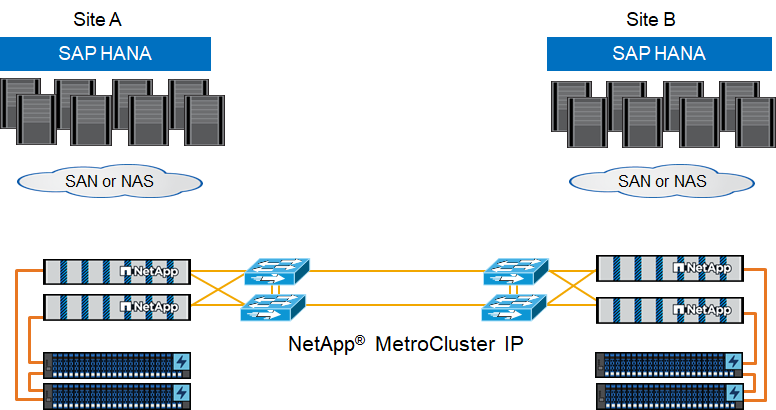Architecture
 Suggest changes
Suggest changes


SAP HANA hosts are connected to storage controllers using a redundant FCP infrastructure and multipath software. A redundant FCP switch infrastructure is required to provide fault-tolerant SAP HANA host-to-storage connectivity in case of switch or host bus adapter (HBA) failure. Appropriate zoning must be configured at the switch to allow all HANA hosts to reach the required LUNs on the storage controllers.
Different models of the AFF system product family can be mixed and matched at the storage layer to allow for growth and differing performance and capacity needs. The maximum number of SAP HANA hosts that can be attached to the storage system is defined by the SAP HANA performance requirements and the model of NetApp controller used. The number of required disk shelves is only determined by the capacity and performance requirements of the SAP HANA systems.
The following figure shows an example configuration with eight SAP HANA hosts attached to a storage HA pair.
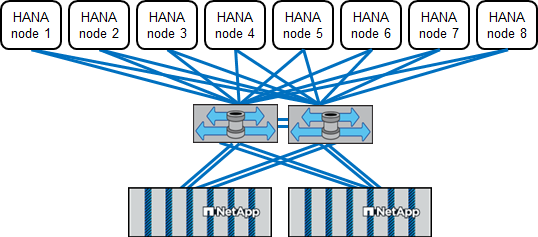
This architecture can be scaled in two dimensions:
-
By attaching additional SAP HANA hosts and storage capacity to the existing storage, if the storage controllers provide enough performance to meet the current SAP HANA KPIs
-
By adding more storage systems with additional storage capacity for the additional SAP HANA hosts
The following figure shows a configuration example in which more SAP HANA hosts are attached to the storage controllers. In this example, more disk shelves are necessary to meet the capacity and performance requirements of the 16 SAP HANA hosts. Depending on the total throughput requirements, you must add additional FC connections to the storage controllers.
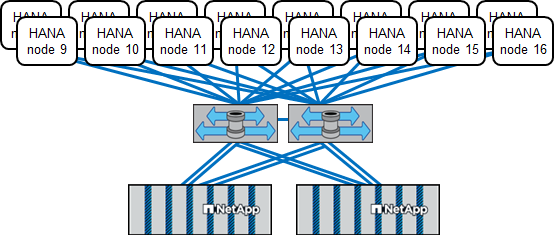
Independent of the deployed AFF system, the SAP HANA landscape can also be scaled by adding any certified storage controllers to meet the desired node density, as shown in the following figure.

SAP HANA backup
The ONTAP software present on all NetApp storage controllers provides a built-in mechanism to back up SAP HANA databases while in operation with no effect on performance. Storage-based NetApp Snapshot backups are a fully supported and integrated backup solution available for SAP HANA single containers and for SAP HANA MDC systems with a single tenant or multiple tenants.
Storage-based Snapshot backups are implemented by using the NetApp SnapCenter plug-in for SAP HANA. This allows users to create consistent storage-based Snapshot backups by using the interfaces provided natively by SAP HANA databases. SnapCenter registers each of the Snapshot backups into the SAP HANA backup catalog. Therefore, backups taken by SnapCenter are visible within SAP HANA Studio or Cockpit where they can be selected directly for restore and recovery operations.
NetApp SnapMirror technology allows for Snapshot copies that were created on one storage system to be replicated to a secondary backup storage system that is controlled by SnapCenter. Different backup retention policies can then be defined for each of the backup sets on the primary storage and also for the backup sets on the secondary storage systems. The SnapCenter Plug-in for SAP HANA automatically manages the retention of Snapshot copy-based data backups and log backups, including the housekeeping of the backup catalog. The SnapCenter Plug-in for SAP HANA also allows for the execution of a block integrity check of the SAP HANA database by executing a file-based backup.
The database logs can be backed up directly to the secondary storage by using an NFS mount, as shown in the following figure.
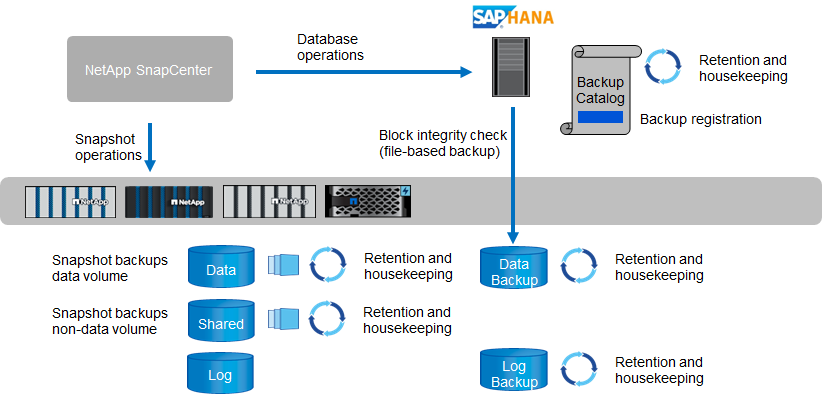
Storage-based Snapshot backups provide significant advantages compared to conventional file-based backups. These advantages include, but are not limited to the following:
-
Faster backup (a few minutes)
-
Reduced RTO due to a much faster restore time on the storage layer (a few minutes) as well as more frequent backups
-
No performance degradation of the SAP HANA database host, network, or storage during backup and recovery operations
-
Space-efficient and bandwidth-efficient replication to secondary storage based on block changes
For detailed information about the SAP HANA backup and recovery solution, see TR-4614: SAP HANA Backup and Recovery with SnapCenter.
SAP HANA disaster recovery
SAP HANA disaster recovery can be done either on the database layer by using SAP HANA system replication or on the storage layer by using storage replication technologies. The following section provides an overview of disaster recovery solutions based on storage replication.
For detailed information about the SAP HANA disaster recovery solutions, see TR-4646: SAP HANA Disaster Recovery with Storage Replication.
Storage replication based on SnapMirror
The following figure shows a three-site disaster recovery solution using synchronous SnapMirror active sync to the local DR datacenter and asynchronous SnapMirror to replicate the data to the remote DR datacenter.
SnapMirror active sync enables business services to continue operating even through a complete site failure, supporting applications to fail over transparently using a secondary copy (RPO=0 and RTO=0). There is no manual intervention or custom scripting required to trigger a failover with SnapMirror active sync.
Beginning with ONTAP 9.15.1, SnapMirror active sync supports a symmetric active/active capability. Symmetric active/active enable read and write I/O operations from both copies of a protected LUN with bidirectional synchronous replication so that both LUN copies can serve I/O operations locally.
More details can be found at SnapMirror active sync overview in ONTAP.
The RTO for the asynchronous SnapMirror replication primarily depends on the time needed to start the HANA database at the DR site and load the data into memory. With the assumption that the data is read with a throughput of 1000MBps, loading 1TB of data would take approximately 18 minutes.
The servers at the DR sites can be used as dev/test systems during normal operation. In the case of a disaster, the dev/test systems would need to be shut down and started as DR production servers.
Both replication methods allow to you execute DR workflow testing without influencing the RPO and RTO. FlexClone volumes are created on the storage and are attached to the DR testing servers.
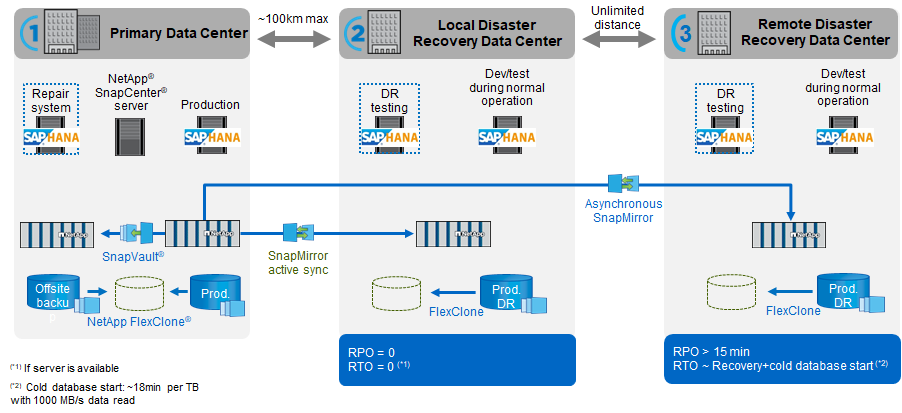
Storage replication based on NetApp MetroCluster
The following figure shows a high-level overview of the solution. The storage cluster at each site provides local high availability and is used for the production workload. The data of each site is synchronously replicated to the other location and is available in case of disaster failover.
